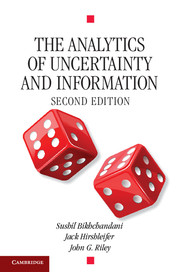Book contents
- Frontmatter
- Contents
- Acknowledgments
- In Memoriam
- Introduction
- Part I
- Part II
- 5 Information and Informational Decisions
- 6 Information and Markets
- 7 Strategic Uncertainty and Equilibrium Concepts
- 8 Informational Asymmetry and Contract Design
- 9 Competition and Hidden Knowledge
- 10 Market Institutions
- 11 Long-Run Relationships and the Credibility of Threats and Promises
- 12 Information Transmission, Acquisition, and Aggregation
- Index
- References
6 - Information and Markets
Published online by Cambridge University Press: 05 August 2013
- Frontmatter
- Contents
- Acknowledgments
- In Memoriam
- Introduction
- Part I
- Part II
- 5 Information and Informational Decisions
- 6 Information and Markets
- 7 Strategic Uncertainty and Equilibrium Concepts
- 8 Informational Asymmetry and Contract Design
- 9 Competition and Hidden Knowledge
- 10 Market Institutions
- 11 Long-Run Relationships and the Credibility of Threats and Promises
- 12 Information Transmission, Acquisition, and Aggregation
- Index
- References
Summary
In Part I, dealing with the economics of uncertainty, after covering the “terminal” decisions of the individual in Chapters 1 through 3 we moved on in Chapter 4 to consider market equilibrium. And similarly here in the realm of the economics of information: having examined individuals’ “nonterminal” (informational) decisions in Chapter 5, we now turn to the analysis of the market equilibrium generated thereby.
A first key distinction is between public and private information. If an information service provides public information, decision makers throughout the economy will be attempting to revise their portfolios in the light of their changed beliefs. Consequently, asset prices will adjust. In particular, market values will rise for those assets paying off more handsomely in states of the world now regarded as more likely. If, on the other hand, the message provided is strictly private, an informed party may be able to profit in various ways without any noticeable effect upon prices. However, as we shall see, almost always there are processes at work tending to “publicize” private information. Sometimes this occurs because the informed individual can gain by intended disclosure of his data, for example, if he sells it to others. Or sometimes there may be unintended leakage into the public domain – owing, perhaps, to the fact that the uninformed can monitor the behavior of those who are informed. These more difficult problems are reserved for later in this chapter; only fully public information will be examined initially.
- Type
- Chapter
- Information
- The Analytics of Uncertainty and Information , pp. 224 - 269Publisher: Cambridge University PressPrint publication year: 2013



